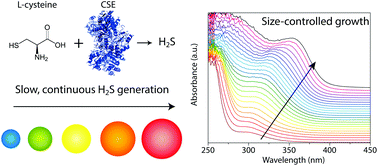Low temperature aqueous synthesis of size-controlled nanocrystals through size focusing: a quantum dot biomineralization case study†
Abstract
Traditional quantum dot synthesis techniques rely on the separation of nucleation and growth to control nanocrystal size. However, the same goal can be achieved through slow and continuous introduction of reactive precursors to keep the growth mechanism in the size focusing regime throughout synthesis. In this work, we demonstrate the efficacy of this approach within the framework of functional material biomineralization where, despite simultaneous nucleation and growth of particles, this growth mechanism enables size-controlled nanocrystal synthesis. Herein, the single enzyme cystathionine γ-lyase (CSE) is utilized to biomineralize CdS nanocrystals via the slow, but continuous turnover of the amino acid L-cysteine to produce H2S. Nanocrystal nucleation and growth theories confirm that consistent addition of monomers will result in a high supersaturation term, driving the nanocrystal growth mechanism into the size focusing regime. We further confirm this theory by mimicking biomineralization via chemical routes and demonstrate the influence of varying supersaturation, to further control the average nanocrystal size. Finally, altering the chelation strength of the capping agent L-cysteine is found to play a key role in balancing nanocrystal growth in solution and long-term stability.



 Please wait while we load your content...
Please wait while we load your content...
